You will swoon over this easy Blackened Mahi Mahi Recipe! Coated in a blend of homemade Cajun blackening spices and pan-seared in a screaming hot cast-iron skillet, these mahi mahi fillets are moist with a crispy, spicy, flavor-packed crust!
Like my zesty Blackened Grouper, Buffalo Shrimp, Lemon Pepper Salmon, and Blackened Cod, this mahi mahi is incredibly delicious and simple to prepare. And the best part is you can have this fantastic seafood entree on the table in ten minutes.
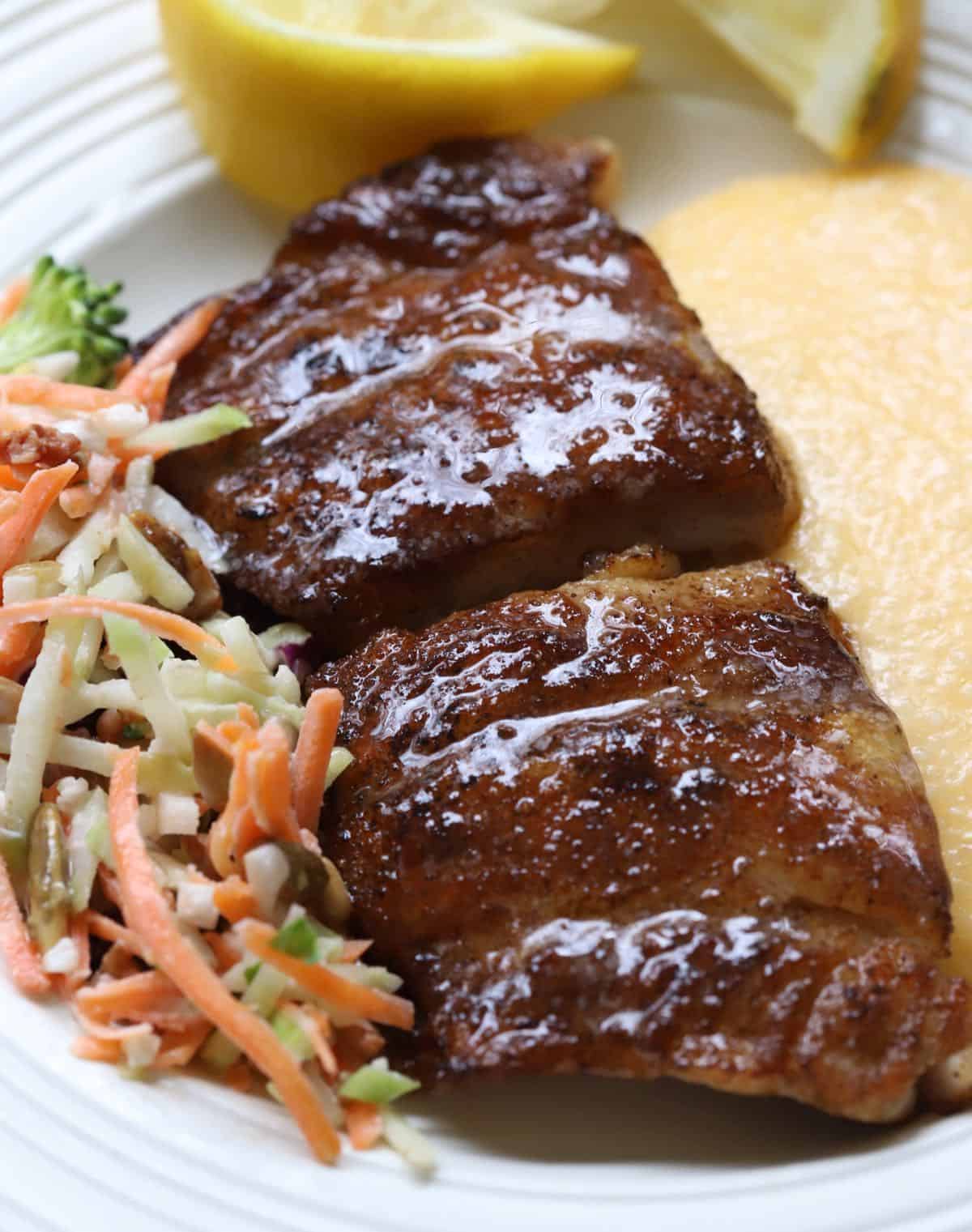
As with my recipe for Blackened Chicken Alfredo, this easy blackened seafood recipe is a restaurant-style main dish that’s as perfect for a busy weeknight dinner as it is for a dinner party.
With firm, white, lean flesh that is slightly sweet and very mild, mahi mahi is a versatile fish that is tasty whether it’s prepared blackened, fried, baked, pan-seared, broiled, or grilled.
Plus, cooking it couldn’t be easier! Check out my simple step-by-step directions, instructional video, and tips to ensure it turns out perfectly.
Jump to:
- Ingredient notes:
- How to make blackened mahi mahi
- Top tip:
- What is mahi mahi:
- What does mahi taste like:
- What to serve with blackened fish:
- What does “blackened” mean:
- What is “blackened” seasoning:
- Recipe variations:
- Leftovers: how to store and reheat.
- How to make this recipe on the grill:
- Recipe FAQs:
- More tips and tricks:
- 📋 Recipe:
Ingredient notes:
(Specific measurements can be found in the recipe below.)
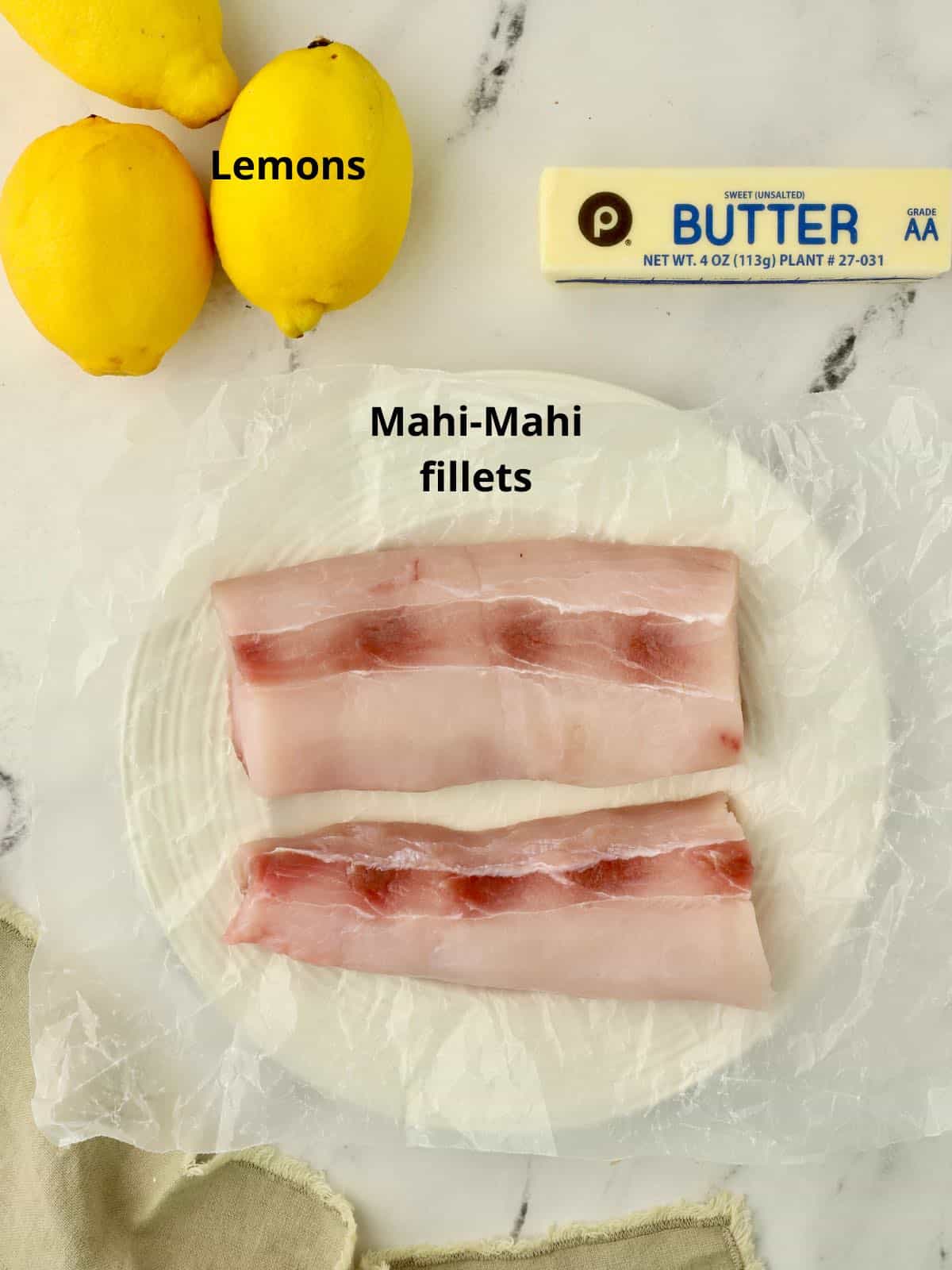
- Fresh mahi mahi fillets – skinned. You can use frozen fish, which must be thawed and dried with a paper towel before cooking. Any firm white fish such as halibut, grouper, snapper, redfish, Corvina, or sea bass make a suitable substitute.
- Butter – coats the fish to help the seasoning stick and adds a rich flavor to the overall dish.
- Fresh lemon juice – there is a scientific explanation, but the best reason is that it gives a delicious flavor to the fish.
Blackened seasoning blend ingredients:
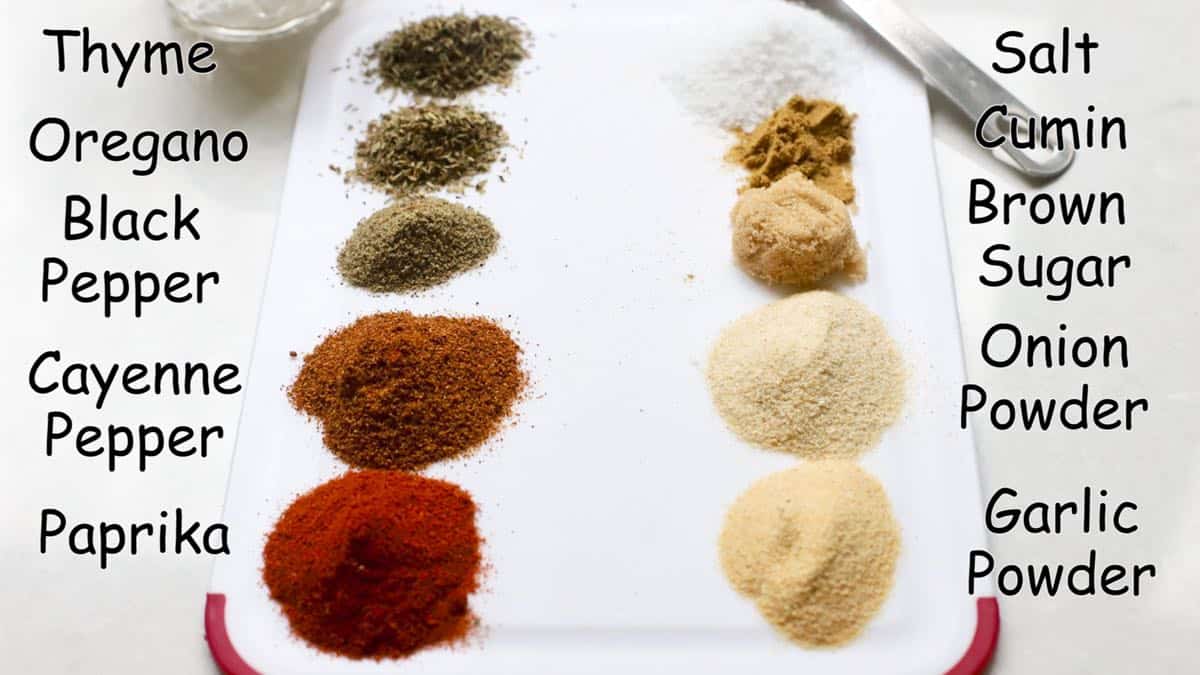
- Cayenne and black pepper – provide a bit of heat.
- Oregano, thyme, and cumin – this spice blend provides a herby, earthy, smoky taste.
- Garlic powder and onion powder – lend their unique flavors to the mix.
- Paprika – adds a bit of color and smokiness.
- Brown sugar: adds just a touch of sweetness that complements the savory spices.
- Kosher salt: enhances all of the flavors and brings everything together.
How to make blackened mahi mahi
- To make the blackened seasoning mix, combine all blackening spices in a small bowl and mix well. Store any leftover seasoning mix in an airtight container for future use.
- Use a paper towel and pat dry the fillets.
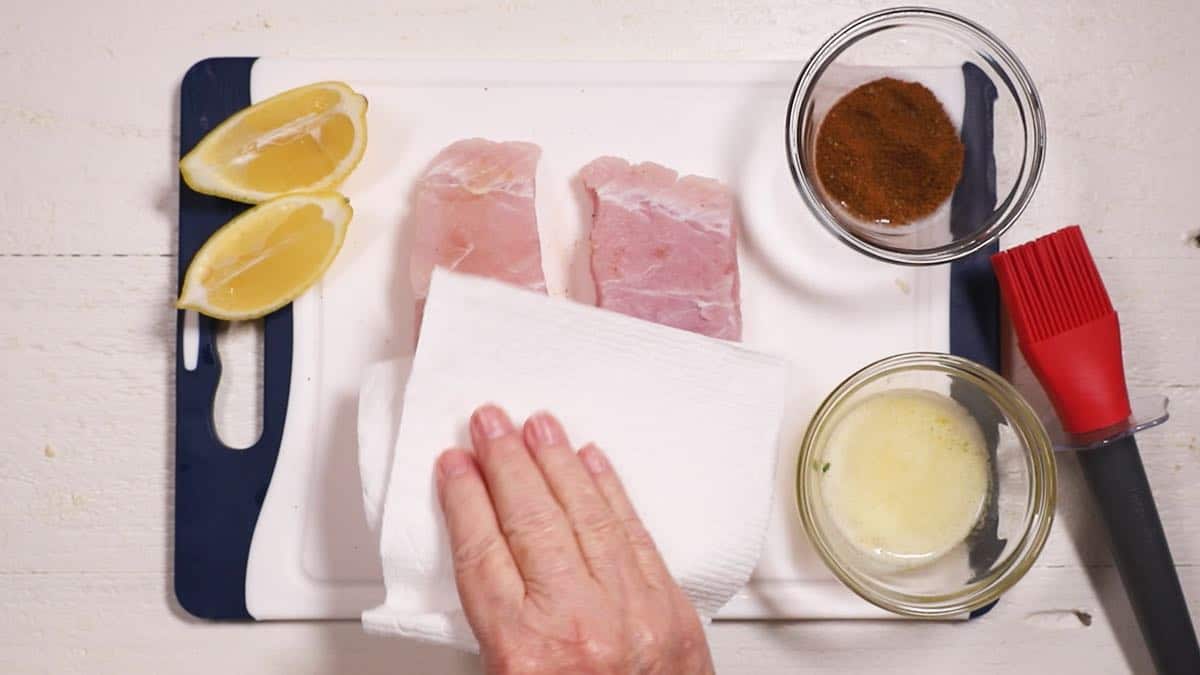
- Melt two tablespoons of butter. Use a pastry brush and coat both sides of the fish with the melted butter.
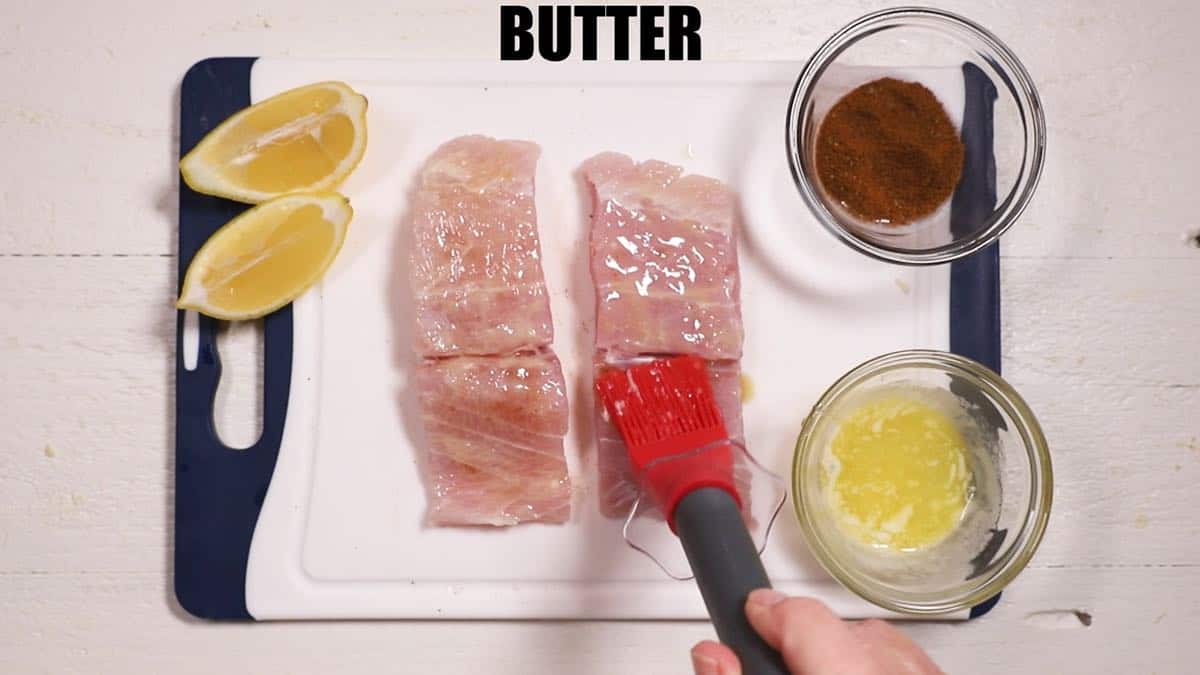
- To season the mahi mahi, top each fillet with a tablespoon of the blackening spice mix and rub it in with your fingers. Then, flip the seasoned fish over and do the same thing on the other side.
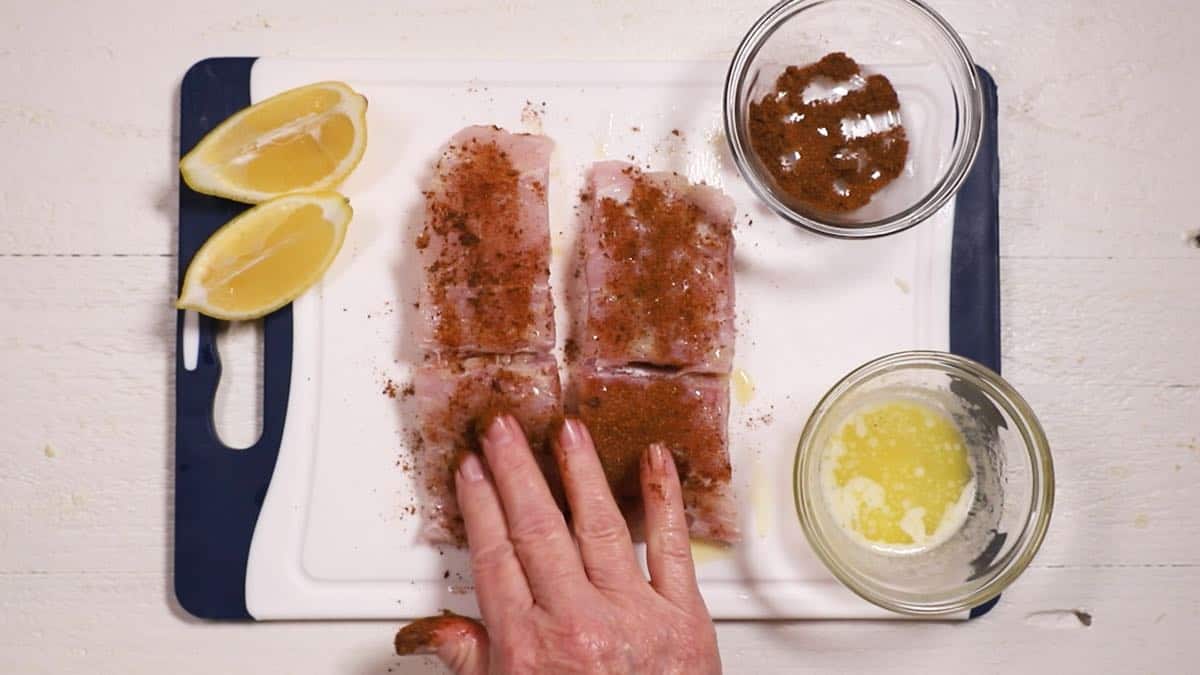
- Add three tablespoons of butter (you can substitute olive oil) to a cast-iron skillet over medium-high heat.
- Set your exhaust fan to high. Blackening fish will produce smoke. When the butter melts, and the skillet is hot, add the fish and let cook undisturbed for three minutes.
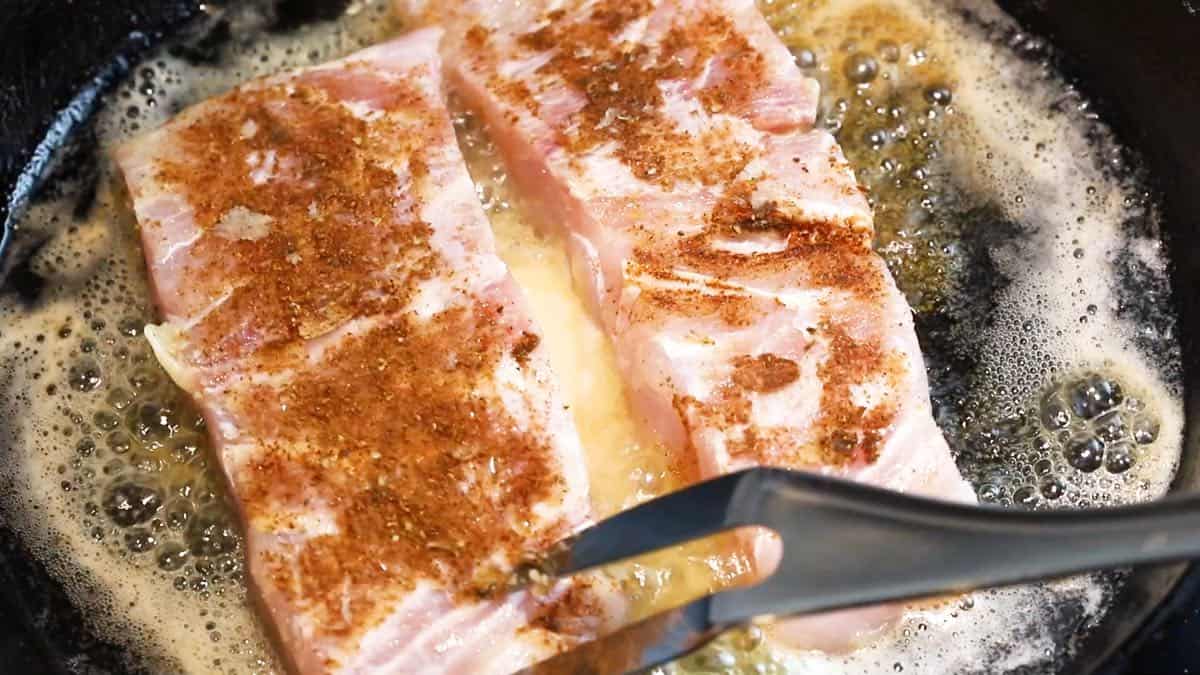
- Use a fish spatula or pancake turner and turn the fillets over. Cook for another 3-4 minutes. You can tell when fish is cooked when the flesh turns from translucent to opaque and flakes easily when pierced with a fork. Be careful not to overcook.
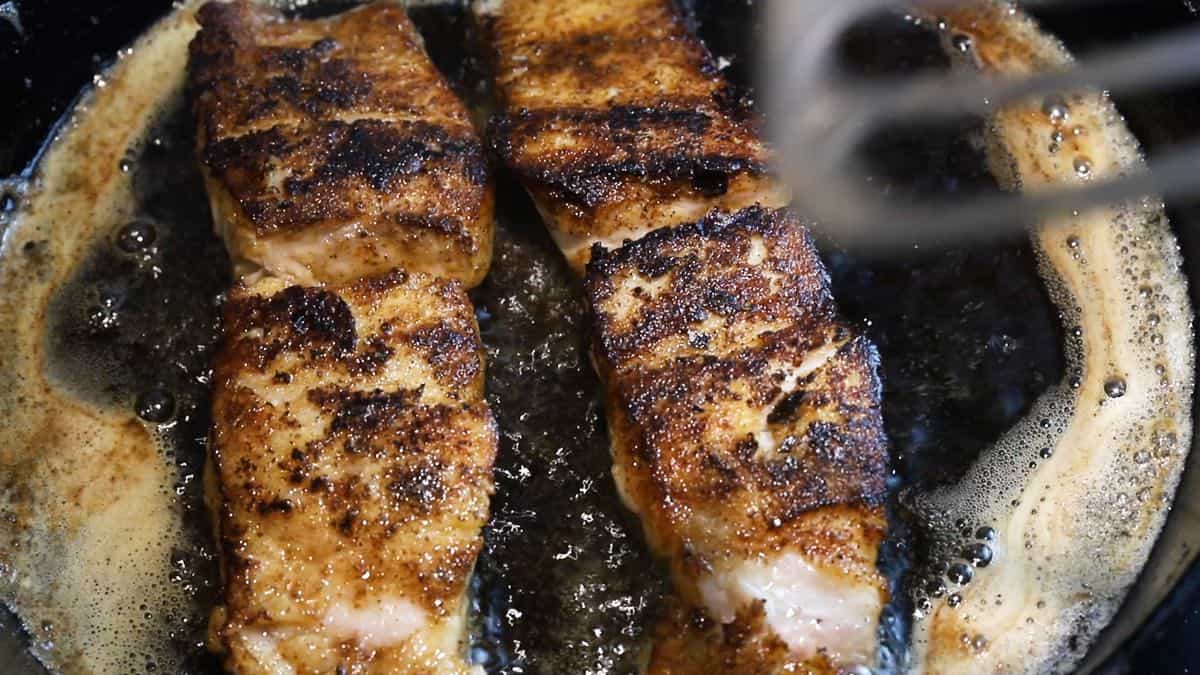
- Serve the blackened mahi mahi hot with a squeeze of lemon juice over the top, or see my other suggested toppings in the “recipe variations” section below.
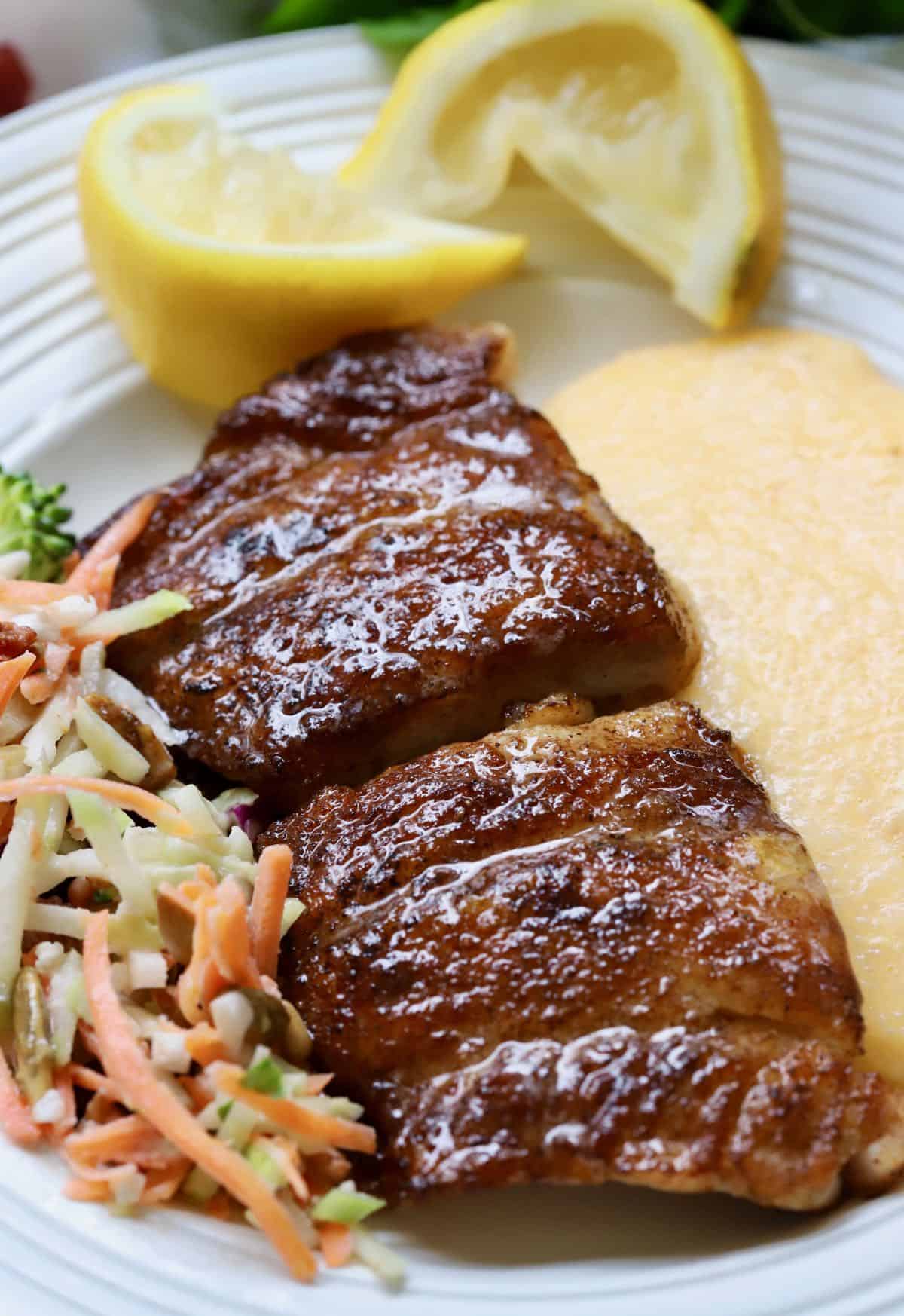
Top tip:
For the most authentic flavor and crunch with this mahi mahi recipe, the best way is to use a cast-iron skillet to blacken your fish. Of course, a heavy-duty non-stick skillet works, too, but you might not get the crispy exterior.
What is mahi mahi:
Closely related to pompano and second only in beauty to red snapper with gorgeous red coloring, mahi mahi is one of the most stunning fish in the world, with iridescent blue, green, and gold coloring.
It is found in warm waters worldwide, including the Gulf of Mexico, and is also called dolphin, dolphin fish, or dorado. But don’t worry; it is unrelated to Flipper or bottlenose dolphins, which are mammals.
What does mahi taste like:
Mahi mahi has a mild, slightly sweet flavor with a firm, moist texture. The flesh is lean and tender with large flakes.
What to serve with blackened fish:
While it’s very common to serve blackened fish over white rice, you might want to try this recipe for Tropical Island Rice or Dirty Rice.
You could also serve your blackened mahi mahi with my favorite Cheese Grits, American Coleslaw, and Hush Puppies.
What does “blackened” mean:
Blackening fish is simply coating it with a rub, which is a blend of blackened spices, and searing it quickly over high heat in a cast-iron skillet until the spices are caramelized and form a deliciously tasty crust with a bold flavor.
While most folks blacken their fish in a cast-iron skillet over a burner on the stove, you can also blacken it outside on a grill in a cast iron pan, blacken it in the oven, blacken it in an air fryer, and even blacken it under a broiler.
What is “blackened” seasoning:
Blackening seasoning is a rub that gives the mahi mahi fillets their flavorful spicy taste, blackened crusty appearance, and delicious crunch.
This delicious blackening seasoning mix can also be used to make Blackened Shrimp and Blackened Steak. I’ve even been known to add a little to soups, stews, and various sauces.
You can substitute it in recipes for homemade Cajun seasoning or Creole seasoning. I always make extra and keep a jar in my pantry.
You can also purchase pre-made blackened seasoning, and you should be able to find it in your grocery store’s spice aisle.
Recipe variations:
- While blackened mahi mahi is delicious, if you are like me and switch things up occasionally, try topping the fillets with a cajun cream sauce or lemon butter sauce.
- It is also delicious when topped with the cool, fresh taste of mango salsa, peach salsa, pineapple salsa, avocado salsa, cucumber salsa, and other fruit salsa.
- It can also be used to make Blackened mahi mahi tacos, wraps, and sandwiches such as a po’boy.
- In addition, it can be added to pasta, substituted for shrimp in shrimp and grits, and makes an excellent and healthy topping for Caesar salad.
Leftovers: how to store and reheat.
Leftovers can be stored covered in the refrigerator for 3-4 days. The fillets can be reheated in a skillet with a bit of oil or butter over medium heat for five to ten minutes.
My favorite way to repurpose leftover fish is by using it to make tasty Fish Cakes.
How to make this recipe on the grill:
To make this recipe on a grill, preheat your grill to high, add your cast iron skillet, preheat it, and follow the directions for cooking it on the stove.
The advantage of cooking it outside is that you won’t have a smoky kitchen if you don’t have a good exhaust fan.
Recipe FAQs:
Mahi mahi has a thick skin that will prevent the blackening seasoning from reaching the flesh. Therefore, it should be removed for this recipe, or you can ask your fishmonger to remove it.
Fish cooks quickly and should be watched carefully. It is done when the flesh turns from translucent to opaque and flakes easily when pierced with a fork. The final internal temperature should be 140°F as measured by an instant-read meat thermometer.
It is a delicious fish that, in addition to blackening, can be prepared in various ways, including grilling, baking, pan-searing, or even as part of a ceviche.
Mahi mahi is a very mild fish; if it is fresh, it should not need soaking.
More tips and tricks:
- As written, The recipe for blackened seasoning is a little spicy. If you want to reduce the heat, reduce the amount of cayenne pepper or eliminate it for the best results.
- Fresh fish can be stored covered in your refrigerator for up to two days. If you need to store it longer, you must freeze it. To freeze fish, wrap tightly to prevent freezer burn. It will keep frozen for up to two months.
- Thaw frozen fish overnight in the refrigerator before cooking, and pat it dry before adding the butter or seasoning.
- When buying fish fillets, plan on approximately 4 to 6 ounces per person and try to get the fillets the same size and thickness so they will cook in the same amount of time.
- You can substitute purchased blackening seasoning for the homemade. I like and have used Old Bay and Paul Prudhomme blends.
- The cooking time shown in this recipe is for fillets that are one-half of an inch thick. If your fillets are thinner or thicker, they will take less or more time to cook properly.
- If you are on a low-carb diet, eliminate or reduce the amount of brown sugar in the seasoning mix.
⭐️⭐️⭐️ ⭐️ ⭐️ If you make this recipe, please leave a comment and give it a star rating. I would love to know how you liked it!
Thank you so much for visiting Grits and Pinecones!
📋 Recipe:
Want to Save This Recipe?
Enter your email & I’ll send it to your inbox. Plus, get great new recipes from me every week!
By submitting this form, you consent to receive emails from Grits and Pinecones.
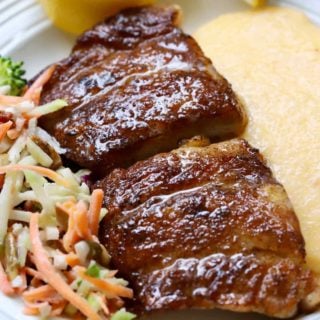
Blackened Mahi Mahi Recipe (Quick & Delicious)
Equipment
- fish spatula or pancake turneer
- cast iron skillet or heavy duty non-stick skillet
Ingredients
- 4 mahi mahi fillets, 4 to 6 ounces each, skinless, about a half-inch thick
- 5 tablespoons unsalted butter, divided
- 1 lemon fresh
Cajun Blackening Spice Mix:
- 2 teaspoons paprika
- 1 teaspoons cayenne pepper
- ½ teaspoon ground black pepper
- ½ teaspoon dried oregano
- ½ teaspoon ground dried thyme
- ½ teaspoon ground cumin
- 1 teaspoon garlic powder
- 1 teaspoon onion powder
- 1 teaspoon brown sugar
- 2 teaspoons kosher salt
Instructions
Cajun Blackening Spice Mix Directions:
- Combine all blackening spices in a bowl to mix the seasoning. Store any leftover seasoning mix in an airtight container for future use.
Blackened Mahi Mahi Directions:
- Use a paper towel and pat dry the fillets.
- Melt two tablespoons of butter. Use a pastry brush and coat both sides of the fillets.
- Top each fillet with about a tablespoon of the blackened spice mix and rub in with your fingers. Flip over and do the same thing on the other side.
- Add three tablespoons of butter (you can substitute olive oil) to a cast-iron skillet over medium-high heat.
- Set your kitchen exhaust fan to high. Blackening fish will produce smoke. When the butter is melted, and the skillet is hot, add the fish and let it cook undisturbed for three minutes.
- Use a fish spatula or pancake-turner and turn the fillets over. Cook for another three to four minutes. You can tell when fish is done when the flesh turns opaque and flakes easily when pierced with a fork. Be careful not to overcook.
- Serve the blackened mahi mahi hot with a squeeze of lemon juice over the top.


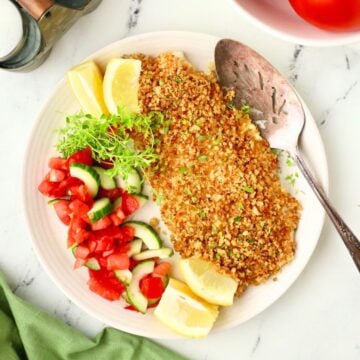




Kristin
So much flavor and so easy. Thanks for the recipe!
Sharon Rigsby
Thanks so much, Kristin; I’m so glad you enjoyed it.
All the best,
Sharon
Sid Parrish
Pepper is included as an ingredient but I did not see it included in the instructions.
Sharon Rigsby
Hi Sid, it is one of the ingredients in the blackening seasoning. It’s just combined with the rest of the ingredients. I hope you enjoy it!
All the best,
Sharon
Paula
This was amazing! So fancy but so easy!! Loved the addition of brown sugar to spice rub, Thank you!
Tony Mowatt
This came out so good tonight! I can’t wait to make it again! So yummy!
Emy
Delicious recipes